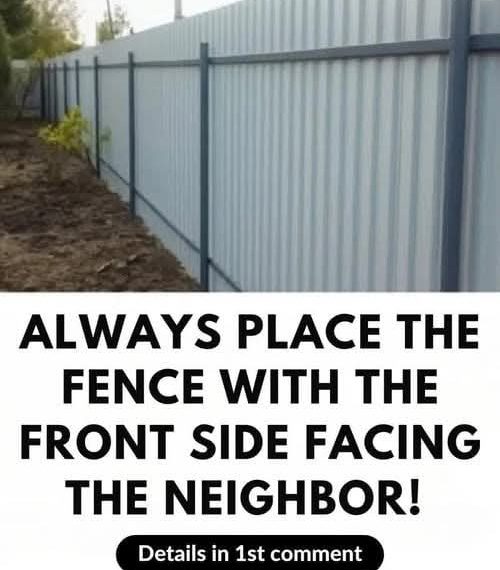When installing a fence, most homeowners focus on its height, material, and color. But there’s one small detail that often gets overlooked — which way the “good side” of the fence should face. If you’re building a traditional wood privacy fence, it’s not just a matter of aesthetics. You should always place the front (finished) side of your fence facing your neighbor. Here’s why — and what could go wrong if you don’t.
🪵 What Do We Mean by “Front” of the Fence?
The “front” of a fence is the smooth, finished side. It’s the one with the clean panels and no visible posts or rails. The “back” of the fence usually shows the structural elements: posts, rails, and horizontal supports.
In most fencing designs — especially stockade, board-on-board, or shadowbox styles — the finished side is meant to face outward.
✅ Top Reasons to Face Your Fence Forward
1. It’s a Matter of Courtesy and Goodwill
Facing the “good side” toward your neighbor shows respect. It tells your neighbors you care about the shared space and want to maintain a positive relationship.
🧠 Think about it: would you like to look out your window and see the ugly backside of someone else’s fence?
Small gestures like this go a long way in building friendly neighborhood vibes — and can prevent years of silent tension or worse, property disputes.
2. It May Be Required by Local Laws or HOA Rules
Many municipal building codes or homeowners’ associations (HOAs) require the finished side of the fence to face outward. Ignoring this rule can result in:
- Fines or penalties
- Orders to tear down or flip the fence
- Legal complaints from neighbors
📜 Example: In Portland, Oregon, the city’s residential fencing code clearly states that the “finished side” of any fence must face outward toward adjacent properties.
Always check with your local zoning department or HOA guidelines before building.
3. Better Curb Appeal = Higher Property Value
The side of your fence that faces the street or your neighbor contributes to your home’s curb appeal. A fence with a finished, attractive front can:
- Improve resale value
- Make your yard look larger and more polished
- Create a good first impression for visitors or buyers
On the other hand, exposing the raw structural side can make your yard look unfinished or even unfriendly.
4. Increases Security and Safety
Ironically, the “bad” side of the fence — the one with the rails and supports — makes it easier to climb. By facing that side inward, you’re reducing access points for:
- Trespassers
- Thieves
- Curious animals or kids
So while it might not seem like a big deal, the orientation of your fence can add a layer of passive security.
5. Legal Ownership and Boundaries Are Clearer
Facing the good side outwards makes it easier to identify who owns the fence. This becomes important if:
- A neighbor wants to attach something to the fence
- Disputes arise over property lines
- Repairs are needed in the future
🧱 Rule of thumb: You own the fence if the posts are on your side of the property line.
Making the finished side face outward makes it less confusing for everyone.
❌ What Happens If You Face the Ugly Side Toward Your Neighbor?
You might save a little time or money in the short term, but you could be asking for trouble:
You might save a little time or money in the short term, but you could be asking for trouble:
- Frustrated neighbors who feel slighted or disrespected
- Possible legal issues if you violated HOA or zoning regulations
- Bad curb appeal that reflects poorly on your home
- Requests to remove or rebuild the fence
In extreme cases, it can even lead to property line lawsuits or official complaints filed with your city or county.
💡 What If You Want a Nice Fence on Both Sides?
If you want a clean, attractive appearance on both sides, consider these styles:
🔄 Shadowbox Fence
- Alternating panels on both sides
- Looks the same from either direction
- Offers airflow and partial privacy
🧱 Board-on-Board Fence
- Overlapping vertical boards on both sides
- Zero gaps and high privacy
- Neighbors appreciate the view too
💰 Split the Cost
In some neighborhoods, neighbors split the cost of a fence — especially if it benefits both sides. If you do this, you may be able to mutually decide on the orientation or style.
Tips for Building a Fence the Right Way
- Survey the property lines before digging. Never guess where the line is.
- Talk to your neighbor ahead of time. It builds trust and prevents surprises.
- Apply for permits if required in your area.
- Use high-quality materials to avoid premature warping or damage.
- Choose a professional installer if the job is complex or requires permits.
🔚 Conclusion: A Simple Decision with Big Impacts
When it comes to fences, the way it faces matters more than most people realize. Always placing the finished side toward your neighbor isn’t just about looks — it’s about respect, rules, and long-term harmony. And if you’re still unsure, remember this golden rule: Treat your neighbor the way you’d want to be treated — especially when it comes to shared boundaries.
❓FAQs
1. Do all fence types have a “good” and “bad” side?
Not all, but many wooden privacy fences do. Styles like shadowbox or lattice are designed to look the same on both sides.
2. Can I put the good side facing in if I don’t have neighbors?
If the fence faces a forest or empty lot, it may not matter. But for visible fences, outward-facing is still better for resale.
3. What happens if my neighbor builds a fence and faces the bad side toward me?
You can ask them to flip it or consult HOA or local code if it’s against the rules. Open communication is key.
4. Do metal or vinyl fences have orientation rules too?
Less so — many are symmetrical. Still, check local codes to be sure.
5. Can I decorate or attach things to my neighbor’s fence?
Only with their permission. The fence legally belongs to whoever installed it — even if it faces your yard.





